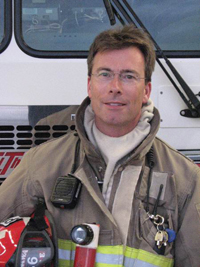
Features
Health and wellness
Hot topics
Minimizing risks for ourselves and others
Fire fighting has always been about doing everything in our power to help the public (our customers) deal with whatever crisis confronts them on any given day. So much so, in fact, that we often neglect our own safety in the process.
January 6, 2009
By Peter Hunt
Fire fighting has always been about doing everything in our power to help the public (our customers) deal with whatever crisis confronts them on any given day. So much so, in fact, that we often neglect our own safety in the process.
 |
|
Often, it’s unavoidable and we place ourselves in harm’s way knowing that our training and equipment will see us through.
But are we doing everything we can to minimize the risks that firefighters face?
For example, to my knowledge, as of this writing, no Canadian fire department has yet issued “self rescue” systems to its members.
Furthermore, many departments lack the resources to provide adequate on-scene RIT personnel.
This month, I offer several suggestions relating to our own safety and survival, all of which can, if necessary, be conducted at the company level.
Bumps to the pump
Some of you may have a different memory aid that you prefer, but I’m talking about a failsafe method of identifying hose couplings that will lead you out of the fire.
As a rookie firefighter, I believed you could only get lost in large, fully involved structures, until the day I got lost in a smoky 1,500 square-foot townhouse.
Years later, I was taught to identify the “bumps” on the male half of the hose coupling and that by following the hose in that direction, I would eventually reach the “pump”, or the outside.
As an officer, and based on my townhouse experience, the “bumps to the pump” drill has become mandatory practice for my crew. In zero visibility, and with gloved hands, firefighters following the hose line can immediately determine the direction in which to travel from the first coupling they encounter that will lead them to safety.
With the cold weather upon us, this is an excellent indoor drill to conduct on the apparatus floor with a blacked out face piece. It also works well when included in your regular training on search patterns for both small rooms and large areas.
However you present it, make sure it becomes second nature for the entire crew.
Mayday, mayday, mayday
How hard can it be for firefighters, who are thoroughly trained in the techniques of rescuing others, to recognize when they are in trouble, activate their man-down feature, and say the words mayday, mayday, mayday into their portable radio?
Apparently, it’s pretty hard. I can’t answer the question myself because I’ve never done it for real, and thankfully, most of us never will.
Evidence has clearly shown that firefighters often refuse to admit to themselves that they’re actually in trouble, struggle to rescue themselves until they’re exhausted and/or out of air, don’t transmit adequate information to allow the RIT team to locate them quickly, or have difficulty operating their radio with a gloved hand in the rapidly deteriorating environment in which they suddenly find themselves.
Yes, even firefighters have to be reminded that it’s OK to ask for help and to do it right away.
Several outstanding training packages can be found on the internet by searching “Calling the mayday”. Find the one that best suits your crew or department and train on it!
The Denver Drill
In September 1992, Denver, Colo., firefighter Mark Langvardt tragically died despite the
Herculean efforts of his fellow firefighters to rescue him from a structure fire in a commercial building.
Although this and many stories like it are long remembered, the important “lessons learned” are often forgotten.
RIT programs in the early ‘90s were still in their infancy in most fire departments, if they existed at all, and it’s not difficult to understand why attempts to rescue firefighter Langvardt were unsuccessful.
Following his death, the Denver Drill was developed and quickly became accepted practice for removing downed firefighters from confined spaces adjacent to an exterior window.
I’m not going to attempt to teach the drill, but I strongly urge you to Google either “Denver Drill” or “Mark Langvardt” and practice this life-saving manoeuvre. It is extremely physical (especially for our smaller members) and must be reviewed regularly to be successful.
In the spring of 2002, I listened to retired Phoenix fire chief Alan Brunicini speak of the loss of one of his members in a tragic event that was subsequently overshadowed by the events of 9-11 and therefore unknown to most of us.
In March 2001, the Phoenix Fire Department believed that it had developed an adequate RIT program.
However, when firefighter Brett Tarver became separated from his crew while exiting a department store fire due to deteriorating conditions, the tragic events that followed forced the department to make dramatic changes to its program. Firefighter Tarver became lost, transmitted a mayday and soon ran out of air. The ensuing rescue (which tragically became a body recovery) required much more time and many more companies than the department had ever imagined.
The most important lesson we can all learn from these and similar tragedies is the importance of assembling adequate personnel early, taking your RIT assignment seriously at all times and always assembling the proper tools and carrying out the proper scene assessment as if a life depends on it.
Peter Hunt, a 29 year veteran of the Fire Service is a Captain in the Ottawa Fire Departments Suppression Division. He can be reached at peter.hunt@rogers.com
Print this page